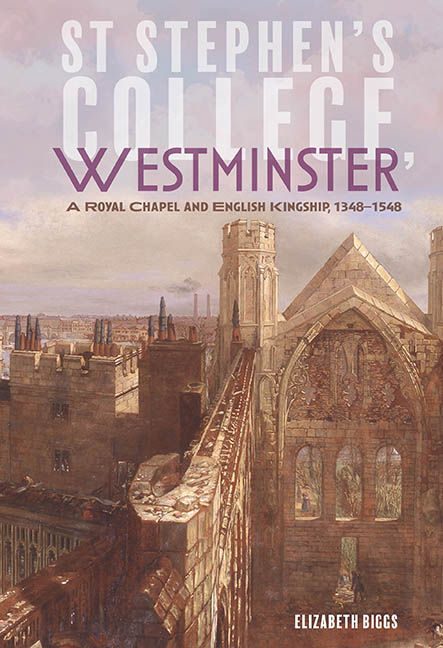Book contents
- Frontmatter
- Contents
- List of Illustrations
- Acknowledgements
- List of Abbreviations
- Preface
- Introduction
- 1 Finding a Place Within Westminster, 1348–1394
- 2 Magnificence and Difficulties under Richard II, 1377–1399
- 3 Weathering Political and Economic Storms, 1399–1485
- 4 A New Kind of Court? Display, Pageantry and Worship, 1471–1536
- 5 Responding to the Reformation, 1527–1548
- Conclusions
- Bibliography
- Index
- Miscellaneous Endmatter
- Frontmatter
- Contents
- List of Illustrations
- Acknowledgements
- List of Abbreviations
- Preface
- Introduction
- 1 Finding a Place Within Westminster, 1348–1394
- 2 Magnificence and Difficulties under Richard II, 1377–1399
- 3 Weathering Political and Economic Storms, 1399–1485
- 4 A New Kind of Court? Display, Pageantry and Worship, 1471–1536
- 5 Responding to the Reformation, 1527–1548
- Conclusions
- Bibliography
- Index
- Miscellaneous Endmatter
Summary
St Stephen's College occupied an important chapel that dominated the Thames riverfront of the medieval Palace of Westminster among the offices of government and the royal lodgings. The chapel offered a vantage point to observe displays of kingly legitimation, collaborations between the kings of England and the Church, and the audiences who thronged to Westminster to seek access to governance. Its liturgy and music reflected royal piety and commemoration of the royal dead. Each chapter here deals with St Stephen's from a slightly different perspective as the college and the expectations of kingship changed over two centuries. It first examines the religious and political contexts in which the college was founded and in which it had to establish its rights, until a final settlement with Westminster Abbey was reached in 1394. From 1377, Richard II adapted his grandfather's foundation as his own as he sought to remake the palace in his own image. During the dynastically troubled fifteenth century, the dean and canons of St Stephen's used its importance to the kings of England to maintain and develop its position as the ‘king's chief chapel’. The increasing presence of the populace as an audience to events at Westminster shaped the college's development and buildings after 1471 before, finally, the Reformation both revitalised and then destroyed it. The empty chapel then became the first permanent home of the House of Commons. This book examines St Stephen's College as a key institution within the most important English palace: its buildings, its personnel and its relationships with every king between 1348 and 1548.
- Type
- Chapter
- Information
- St Stephen s College WestminsterA Royal Chapel and English Kingship, 1348–1548, pp. xi - xiiPublisher: Boydell & BrewerPrint publication year: 2020

